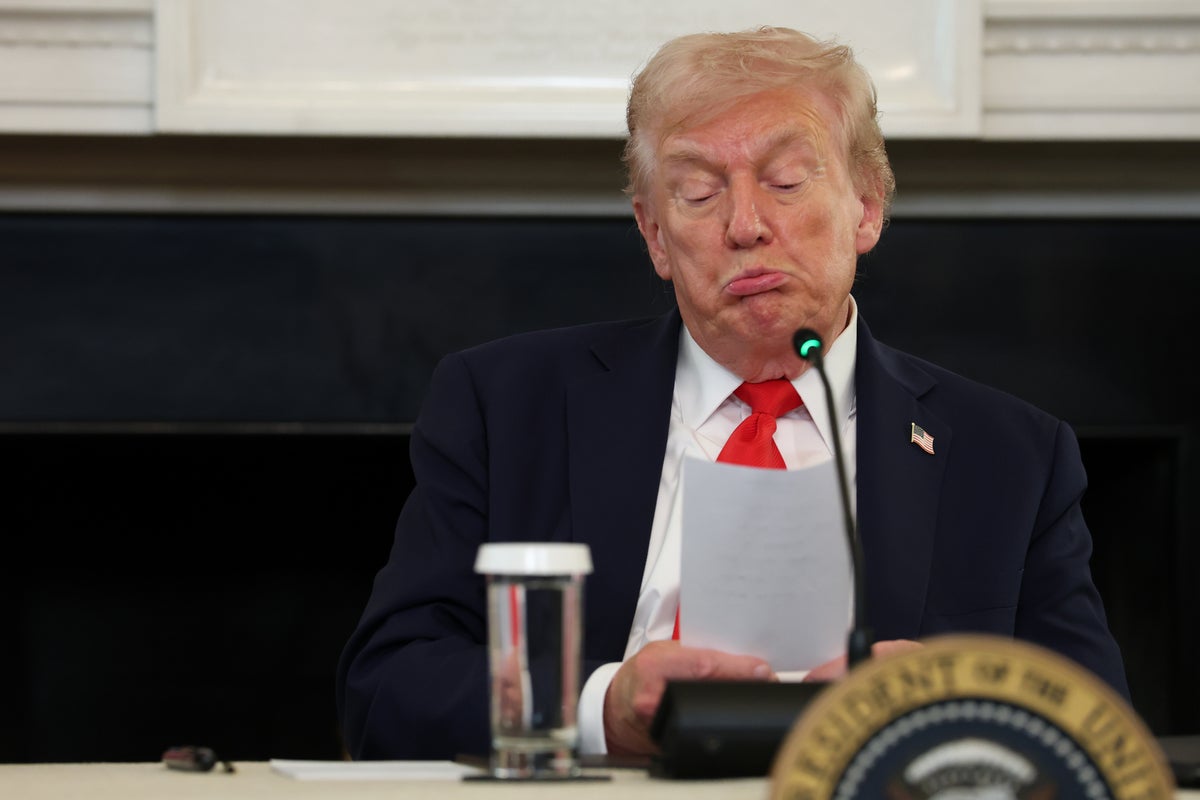
President Donald Trump appeared confused when asked if he was considering suspending habeas corpus – a Constitutional right that allows people to challenge unlawful detention – responding, “Suspending who?”
The 79-year-old president was taking questions from conservative influencers in the State Dining Room of the White House Wednesday as part of a roundtable on so-called “Antifa terror” when he was asked about how he plans to handle the anti-fascist movement.
Antifa, short for anti-fascist, is a term used to describe left-wing activists that the Trump administration has villainized. On Wednesday, the president said he is designating Antifa as a major “domestic terrorist” organization for protesting his Immigration and Customs Enforcement policies.
During the roundtable, Trump was asked: “Have you given any more thought to possibly suspending habeas corpus to not only deal with these insurrectionists across the nation, but also to continue rapidly deporting illegal aliens?”
“Suspending who?” Trump responded, either mishearing the question or thinking habeas corpus was a person.
“Habeas corpus,” the person repeated, causing Trump to defer to Homeland Security Secretary Kristi Noem, who was sitting alongside him during the panel.
“I don’t know. I’d rather leave that to Kristi,” he said, turning to ask Noem, “What do you think?”
Noem awkwardly replies, “No, sir. I haven’t been part of any discussions on that.”
Trump quickly moved on to the next question. The White House did not immediately return The Independent’s request for comment on the incident.
Habeas corpus is a Latin term that means “you have the body.” The right of habeas corpus is directly given in Article I of the U.S. Constitution, allowing those detained by the government to challenge their detention by filing a petition with a court that has jurisdiction.
All people in the U.S., including immigrants, are awarded habeas corpus. However, it can be suspended “in cases of rebellion or invasion” if public safety requires it.
While Trump stumbled over the question, Noem may not have been the best person to ask about the fundamental right. In May, as the White House threatened to suspend habeas corpus, Noem stunned members of a Senate hearing when she completely blundered its definition.
When asked by Senator Maggie Hassan to define it, Noem claimed it is “a constitutional right that the president has to be able to remove people from this country.”
Hassan, a New Hampshire Democrat, interrupted Noem, declaring, “That’s incorrect.”
As Trump’s latest gaffe went viral online, California Gov. Gavin Newsom jumped on another opportunity to dunk on him, simply writing, “Comforting,” along with the clip.
Other social media critics mockingly suggested that Trump thought he was suspending a person, instead of the constitutional right protecting people from unlawful detention.
“President Non Compos Mentis has no idea what the writ of habeas corpus is,” wrote conservative lawyer George Conway on X.
Another social media user joked, “Habeas Corpus, I hear he’s doing very well. Very strong, very powerful.”
During Wednesday’s roundtable, Trump said he was going to designate Antifa a foreign terror organization. He designated it a domestic terror group last month. Antifa is not a single organization but rather a loosely affiliated, left-wing movement with no central hierarchy, organization or clear membership structure.
Its adherents have used a variety of protests strategies, including violence, as part of their activism, and Antifa-style protesters have a presence on the West Coast in cities like Portland and Seattle.
Trump’s former FBI director, Christopher Wray, told Congress in 2020 that Antifa is “not a group or an organization,” but rather a “movement or an ideology.”
The Anti Defamation League describes Antifa as “a decentralized, leaderless movement composed of loose collections of groups, networks and individuals.”
Even so, Attorney General Pam Bondi backed Trump’s attacks on the movement.
“Fighting crime is more than just getting the bad guy off the streets,” Bondi said. “It’s breaking down the organization brick by brick, just like we did with the cartels. We’re going to take the same approach, President Trump with Antifa, destroy the entire organization, from top to bottom. We’re going to take them apart.”
It was not immediately clear what may change under the new designation. The U.S. government does not provide a “precise, comprehensive, and public explanation” of groups it may consider to be domestic terrorist organizations, in part because of free speech concerns, according to a 2023 Congressional Research Service report.
Trump first said he was going to designate Antifa as a terrorist organization during his first term as president during protests against the murder of George Floyd in 2020.
